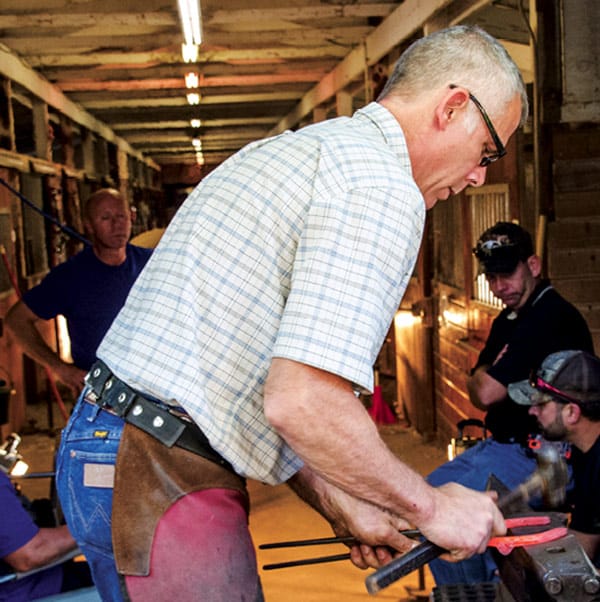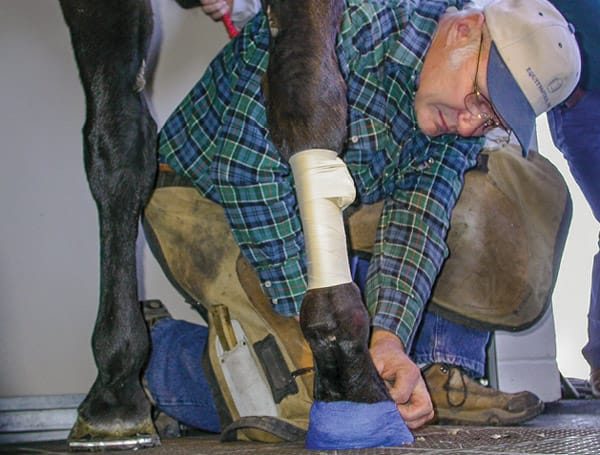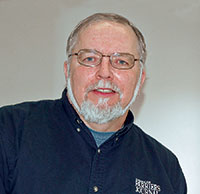Pictured Above: Kirk Adkins applies corrective shoes to the hooves of a windswept foal. Therapeutic supplies don’t need to be too different from the regular equipment farriers use, he says. Photo: Kirk Adkins
It seems almost counterintuitive to think that building and applying the complicated appliance often needed in therapeutic shoeing could be a losing proposition for a farrier. But that can easily become the case unless some thought and reasoning are given to properly charging for the work.
Many novice hoof-care providers start out by charging a set amount per horse, with some variations based on differences between jobs (one price for a trim, a higher price for two shoes, a still higher price for four shoes, etc.). They might charge extra for materials beyond shoes and nails (pads for instance), but if one horse takes a little longer than another, many won’t charge extra, figuring the time will even out over the course of a day.
But an approach like that can be a financial disaster with therapeutic shoeing, where one job can eat up a big part of a shoer’s day.
Farrier Takeaways
- Therapeutic shoeing usually requires more time, equipment and expertise. It’s important to make sure you are being adequately compensated.
- Charge by the hour and not the shoeing job. Don’t forget to charge for travel and time spent waiting for radiographs, evaluations and callbacks.
- Learning therapeutic shoeing takes time and effort. You’ll need to put in time with more
For advice on making therapeutic shoeing pay, we talked with a trio of experienced farriers whose careers have included significant amounts of that kind of work. They include:
Todd Allen, of Vandergrift, Pa. Allen has been shoeing horses since the mid-1980s. He has worked with a number of veterinarians during his career, particularly with equine veterinarian James Zeliff, founder of Allegheny Equine in Murrysville, Pa.
Kirk Adkins, of Vacaville, Calif. Adkins has been shoeing horses since 1971. He spent almost 20 years at the University of California-Davis Veterinary Medicine Teaching Hospital, including 16 years as the staff farrier. He is also the founder and president of Equithotics Inc., and inventor of the Equithotics Sneakers, as well as other farrier products. He has shod many high-end horses in the United States, as well as other countries.
Ingo Wolters of Santa Ynez, Calif., began shoeing in Germany in 1991 and first came to the United States in 2008.
Charging By The Hour, Not The Job
None of these farriers do therapeutic shoeing exclusively, but all agree on the importance of making sure they are paid properly for the work. That, they say, means charging by the hour and not the appointment or shoeing job.
Adkins and Allen suggest a base rate of $100 an hour, while Wolters goes even higher, at $200.
“Normally, I talk with the veterinarian and we make a plan about how and what we can change with a particular horse,” says Wolters, describing his approach to therapeutic work. “We try to work out some things in advance to help manage the time, but you still really should be paid by the hour.”
Wolters points out that therapeutic work can involve shoeing a horse more than one time in the same day, as well as a lot of time waiting for things such as radiographs and evaluations of how a horse is responding to a particular appliance or treatment.
“You have to understand how much you need to make in an hour, as well as understand what you can charge in the area you are working in,” he explains.
He stresses that should all be explained to the client in advance as well.
Allen admits he’s often told he’s not charging enough for his therapeutic work but says he bases his $100-an-hour therapeutic rate off of what he averages an hour for his regular shoeing.
“With so many of these cases, I have a lot of wasted time,” he explains. “I have downtime while the vet is doing his thing or taking X-rays. Or I’m spending time experimenting with various appliances.”
In addition to the hourly rate, Allen will also add a materials charge.

When taking on therapeutic horses, Ingo Wolters acknowledges there is less time for other horses but more learning opportunities. Photo: Ingo Wolters
Get Paid For All Your Time
Adkins is even more particular about charging for his time. He emphasizes that setting that hourly rate is just the beginning. You need to make sure to get paid for all of the time involved in a case, particularly time spent traveling.
“The time thing is something that a lot of guys just don’t understand,” he says. “You need to get paid for your time to the horse and back. Ordinarily, if you drove 50 miles out and 50 miles back and shod six horses during that day, you’d amortize that travel time over six horses. But when you travel that far to shoe just one horse in a therapeutic case, you can’t spread that travel out. And you can’t afford to not be paid for the time.”
Adkins benefited from working with experienced farriers earlier in his career, including the late Hall Of Fame farrier Burney Chapman of Lubbock, Texas.
“He told me, ‘I’m on the clock for the whole day, whether I’m sitting on my butt on an airplane or working on your horse.’”
One way Adkins deals with the time issue is by giving owners the option of bringing their horses to his to well-equipped shop.
“Let them pay for the travel time,” he suggests. “And with a well-equipped shop, you are going to be able to work more efficiently. You can have everything you need set up and ready to go.”
Another option is to meet the client and the horse at a veterinary clinic. Adkins says that especially makes sense if the case is going to involve blocking, sedation or radiographs.
“A client has to understand how this kind of work affects you and your ability to make money,” he says. “I’ll explain that I can shoe three or four regular horses in 3 hours and make $400. If I spend 3 hours just on your horse, I need to be compensated.”
Adkins also stresses the importance of being paid for your expertise.
“If you are doing welding, or drilling and tapping,” he says, “you need to be paid for your ability to do that work.”
Adkins points out that you have to put in a lot of time and effort to develop your skills and techniques, as well as your understanding and knowledge of equine anatomy and pathology to be able to do high-end therapeutic work. That’s a benefit to the horse owner and veterinarians, too.
“It can be a bonus for a veterinarian to be able to bring in an expert farrier for a particular situation,” he notes.
Investing In Equipment
Some farriers who are considering doing more therapeutic work might wonder whether they need to invest in specialized equipment. There’s not a clear-cut consensus on that. Wolters and Allen both say they are able to do most of their therapeutic work with their regular equipment. But the “regular” equipment of an experienced farrier whose book includes high-end horses is likely to be much more extensive than that of a novice who is just getting started.
“I keep my regular supplies well stocked and that is usually enough,” says Wolters. “I have the inserts and pads I need. I sometimes travel a distance to shoe, and I can stay 2 days and shoe as many as 20 horses and still have plenty of supplies.”
Wolters notes that part of being able to do therapeutic work is having the forging skills to modify shoes or forge needed shoes.
You need to make sure to get paid for all of the time involved in a case, particularly that spent traveling …
Allen has also found that he can usually do therapeutic work without using a lot of special equipment.
“If you’re a creative person, you can usually adjust what you have to get the job done,” he says. “I find it’s usually more important to understand what’s going on and apply the basics than have a lot of special stuff.”
Allen suggests that it’s not so important to have stocks of specialized equipment for therapeutic shoeing as it is to understand how to use it when you do need it.
“If you’re putting on a pair of Steward Clogs, you have to understand Mike Steward’s theories behind how to use them,” he says, speaking of the therapeutic appliance developed by the Shawnee, Okla., veterinarian.
For therapeutic cases, Allen also believes you should know how to glue on shoes and use casting materials.
“I’ve used glue-on shoes and casting materials in a lot of cases,” he says. “I’ve also found that if you have an assortment of Vettec products, you can get through a lot of things. We use a lot of Equi-Pak.”
Get A Boost From Power Tools
Adkins finds power tools play an important role in his therapeutic shoeing.
“You don’t have time to make it all from scratch,” he says. “It’s important to be able to deliver the appliances that are needed as quickly and efficiently as possible.”
In addition to regular shoeing tools, his rig and shop are equipped with welding rigs, power saws, angle and belt grinders, drill presses, hand drills and more. Being well equipped also allows him to prepare in advance, which means he can spend less time actually working on the horse.
And while Adkins says he doesn’t use glue-on shoes often, he does manufacture a lot of treatment or hospital plates. He makes sure to have a supply of sheet metal for making the plates, as well as nuts and bolts for the opening and closing mechanisms. He’s also skilled at building and applying braces, splints and similar devices and makes sure to have the materials on hand for that work.
Adkins finds long-heeled horseshoes particularly useful in therapeutic cases, although he says they aren’t as easy to get as they once were, since some manufacturers no longer make them. Long-heeled shoes are his “go-to” appliance for many situations because they can be easily converted into bar shoes, and other modifications can be made as needed.
Skills And Knowledge Level
The biggest challenge to any novice hoof-care provider who wants to do some therapeutic shoeing is developing the skills and knowledge to do the work, as well as solid relationships with veterinarians, trainers and more experienced farriers.
Both Adkins and Allen suggest the American Farrier’s Association’s Certified Journeyman Farrier skills are a good skills benchmark for a shoer who wants to do therapeutic shoeing.
All three farriers also stress the importance of having a good understanding of anatomy and conformation, as well as issues that are related to various types of equine work or disciplines. Adkins holds a bachelor’s degree in animal science and studied pathology in graduate school. While college degrees aren’t a requirement for providing hoof care, understanding factors such as the inflammation process is extremely beneficial.
While these farriers all stress the need to be compensated adequately for therapeutic work, they also say you’ll have to put in your “apprenticeship” before you will be able to do that. They advise giving the manner some thought before you start to take on serious therapeutic work.
“If you’ve got 150 horses on your books and are doing a lot of shoeing, it doesn’t pay to do therapeutic shoeing,” says Adkins. “You have to commit yourself to being a good therapeutic shoer. You’re probably going to need to have fewer horses on your books and put in the time to learn this work. This kind of work, particularly the difficult cases or horses, also involves more callbacks and those take time.”
Adkins points out that it takes time to develop such expertise, as well as the reputation that can go with it.
“You may have to work cheap or even for free at times to learn and build up your reputation,” he says. “You have to spend some time working with people who know more than you do, and you also have to develop relationships with veterinarians.”
Wolters notes that in Germany, a system is in place that allows young farriers with journeyman skills to actually spend a year or 2 working in various locations and disciplines for what amounts to room, board and a small living stipend. For U.S. farriers interested in doing therapeutic work, he suggests considering a similar approach.
“If you could take a year and travel around and work with many different experienced farriers and in many different areas, you would learn so much,” he says. “Your whole career would benefit.”

The AFA’s Certified Journeyman skills are a good benchmark for therapeutic shoeing, Todd Allen says.
Two-Way Benefits
Allen believes the knowledge acquired from developing your therapeutic skills will augment your day-to-day shoeing. He says Carlton Smith, his stepson, is a good example.
“He had been riding with me for several years, and I had him work with the veterinarians on some cases so I could do my regular shoeing,” he explains. “He would listen to the vet instead of thinking he already knew everything. Now he can handle just about anything. I call him MacGyver [after the 1980s TV character known for gadget building], and now he’s one of my best resources. I can tell him what I’m dealing with in a particular case and what I need a package to do, and he’ll come up with ideas that work. The thinking he’s learned to do carried over into his daily shoeing. He can tackle almost anything. And he understands the importance of a good foundation on the foot.”
In addition, Smith became much more confident in his abilities and learned to function as an important part of a veterinarian-farrier team.
“A good, experienced vet is a valuable resource,” Allen says. “The benefit to the owner of having a good, experienced vet and a farrier who will think and listen is immeasurable.”
Lifelong Learning
All three farriers also stress the importance of not going it alone. The mentors you learn from can continue to be sources of knowledge and advice throughout your career. They also agree that doing therapeutic shoeing also means you’ll always be learning more yourself.
Wolters believes that the time you put into learning therapeutic shoeing will pay off over time.
“You develop a reputation as being able to handle difficult situations,” he says. “If you get work for a low price, people will use you as long as they have horses. But those are also the first people who get rid of their horses when times are bad. That means the first farriers who are going to run into trouble are the ones who are shoeing the cheap horses.”
Wolters says the problem is exacerbated in parts of California where many ranches that once housed horses are now being sold to people who want to grow grapes for wine.
“Having some versatility is a good way to stay in business,” he says.









Post a comment
Report Abusive Comment